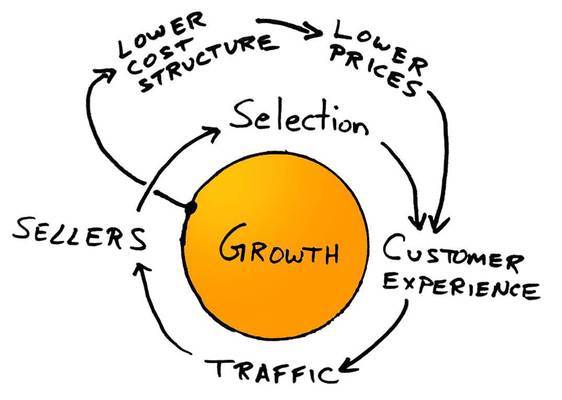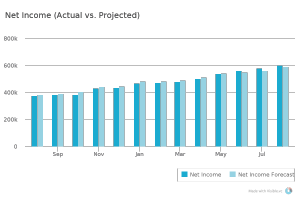Building Your Startup Financial Model
A conversation with Taylor Davidson of Foresight.is
You’ve heard the stories about companies getting funded based on a sketch on the back of a napkin. If your name is Ev Williams or if that napkin sketch is as compelling as Amazon’s, you may have a shot.

via a16z
If you aren’t a founder of Twitter, Blogger, and Medium or spend your free time saving journalism and launching rockets, people evaluating your business are far less likely to take your proclamations about the future at face value.
On this blog, we write a lot about the importance of storytelling for a company. No matter who you are talking to – team members, investors, potential investors – company storytelling doesn’t stop, it simply changes contexts and mediums. A financial model is one of those mediums through which your company can tell its story, even without the operational history one might assume would be necessary to persuade investors or make smart decisions about the direction of the business.
To get a better understanding of what it takes to build a compelling and useful financial model (as well as why it is important), we spoke with Taylor Davidson of Foresight.is. With Foresight, Davidson has built startup financial model templates to help early-stage entrepreneurs spend less time on finance and more time on their products. He has been building startup specific financial models for almost two decades.
The post that follows is drawn from that conversation as well as from our experience at Visible working with private, VC-backed companies on a daily basis.
Where to Start
When Warren Buffett invests in a company, he makes holistic decisions about the quality of the business as if he is buying the whole thing and not simply a decision about the direction the stock might move.
When building a financial model, a similar philosophy applies. Before breaking the business into discrete pieces and asking yourself which direction each will go, first look at the business as a whole and understand both what you as an organization are trying to accomplish as well as what the intended use of the model and startup financial projections you are building will be.
What do we need to accomplish over the next x months…
- …in order to put ourselves into a position to successfully raise a Series A round?
- …for this partnership with Big Co. to make an impact on our bottom line?
- …so that we can hit profitability and maintain optionality over how we finance our future growth (customers vs. investment)?
- …for this product or distribution decision (which puts a significant amount of capital at risk) to pay off?
Being Right is the Wrong Goal

As Davidson put it in our discussion – and in multiple posts on the subject in the past – the goal of a financial model is not to be exactly right with every projection. The more important focus is to show that you, as a founding or executive team, have a handle on the things that will directly impact the success or failure of your business and a cogent plan for executing successfully.
Mark Suster of Upfront Ventures puts it similarly:
See I don’t care if your projections prove wrong over time. I care about your assumptions going in. I care about the thought that you’ve given to the customer problem. I care about how much you’ve thought about market share, competitors, adoption rates, etc.
How to Build Your Startup Financial Model
Among technology companies – especially ones located in a certain geographic region – the very mention of a financial model evokes thoughts of calculator toting, tie-wearing, number crunchers sitting somewhere in a suburban cubicle.
With the direction sentiment is shifting in the early stage market, this mindset couldn’t be further from reality. A well-constructed financial model displays a professional approach to running your business and shows that you “take seriously the fact that you are deploying other people’s capital.”

A good financial model consists to two things:
- Well thought out projections about the future of the business
- A properly structured, understandable, and dynamic spreadsheet
Bottoms Up Startup Financial Projections
A bottoms up financial model – where you start with 5 – 15 core assumptions about the business – is most useful for a company contemplating a specific product direction, distribution strategy (i.e. invest in paid advertising), or a certain partnership that could potentially have a major impact on the business.
Top Down Startup Financial Projections
A top down financial model may be most useful for a company who, for example, knows that it will need to go out and raise $X million in a Series A round 15 months from now and has spent time gathering data on what types of revenue, margins, and growth numbers they need to hit to have a successful fundraise. (Note: If you are a SaaS company, the Pacific Crest SaaS Survey is a great starting point to benchmark yourself)
Maybe in this case, those numbers are $1.5MM in MRR with at least 100% YoY growth. With those in mind, you can work backwards to understand how much you need to grow and which distribution channels may provide the best bridge from where you are now to where you need to be.
Does This Make Sense?
While putting together projections, Davidson recommends constantly asking yourself whether the numbers you are coming up with make sense. To best understand how sensible your projections are, it can be useful to look at things in both directions – top down and bottoms up – to build the right ranges of possible outcomes for your business.
Don’t Reinvent the Wheel…Use a Template
Unless you spent the first couple years of your career cutting your teeth inside an investment bank, your best bet is to lean on existing resources for the structural composition (i.e. the spreadsheet) of your financial model.
The Standard Startup Financial Model that Davidson has put together on Foresight.is has been used by over 15,000 people across the world – from one-person operations just getting started to companies raising large VC rounds or considering acquisitions.
And while we don’t recommend building your model from scratch, it is useful to understand how one can construct a professional financial model. Here are a couple quick resources, recommended by Davidson and us here at Visible:
Finally, if you are looking for a less sophisticated model or something to fit a specific modeling use case (user acquisition, revenue growth, or operations) here is a quick list of resources recommended by Davidson:
Note: You can dive deep into financial modeling and find a ton more great resources by checking out the Foresight blog and reading the Financial Modeling Best Practices post.
Financial Modeling Mistakes
Failing to hit both of the requirements we mentioned in the last section – well thought out projections and a well contstructed spreadsheet – will quickly render your model unusable and will reflect poorly on you as a founder and on your company.
Common Financial Projection Mistakes
- Assuming that revenue will come with scale. While this has long been a criticism of social networks and consumer apps hoping to monetize a critical mass of eyeballs through advertising, many companies who have revenue models built into their businesses from the start (think SaaS or Marketplaces models) still falsely assume that revenue, to the extent they need to be sustainable, will happen once they reach x number of users or “decide to turn on the spigot”.
- Focusing too much on point estimates and not range estimates – As Davidson puts it in a post on his own blog, “instead of agonizing over whether your conversion rate will be 2% or 5%, focus on the possible range or conversion rates and evaluate the results based upon the range of estimates, not the point estimate of 2% or 5%.”
- Not doing your homework – There is a tremendous amount of information available, for free, that can help you gauge your performance and benchmark your growth. We mentioned the Pacific Crest Survey above. Other great resources include AngelList, Mattermark, and the blogs of companies embracing the Radical Transparency movement. On his own blog, Davidson suggests digging into startup post mortems or checking out Quora. Another great place to start is on our Reading List.
Common Spreadsheet Mistakes
- Spending too much time on non-material data points – The Pareto Principle applies here, just as it does to many other undertakings in a startup. While it might seem like spending time optimizing everything in your model will yield the best results, the reality is that going deep on your 5 – 15 core assumptions will yield a much more effective result.
- Failure to design your model for usability – To make your model most effective, you need to pay close attention to how usable the output is for viewers. That means clear explanations, a simple structure, and making sure to follow convention so there are no surprises. We linked to it above but David Teten of ff Venture Capital has a great post on the topic of standardizing the way you build your startup spreadsheets.
- Neglecting to include a sensitivity analysis – This goes back to the idea of understanding what your model outputs look like for a range of estimates. You should also keep in mind that your model should be treated as a flexible, living document. That means that your assumptions shouldn’t be hard-coded. Instead, as Taylor recommends, “create your assumptions so that you can easily change an assumption in one place and all formulas and outputs will recalcuate automatically.”
- Displaying only financial statements and neglecting key metrics – Financial statements go a long way in showcasing the overall health of a business. Unfortunately, many models stop at the financial statements. What investors want to see is a synthesized look at those financials that make it easier to evaluate your business. As an example, a good model won’t just showcase projected revenue growth, it will look at how things like customer growth (and churn) and contract size work together to contribute to that top line number.
Putting Your Financial Model to Work
Another Mark Suster quote sets the tone for how Davidson thinks about taking the financial model you have built and using it to help grow your business:
Financial models are the Lingua Franca of investors. But they should also be the map and the Lingua Franca of your management discussions.
Financial models play a key role in the all of the major discussions you have about your business with all of your key stakeholders. A comprehensive financial model will have within it a number of different pieces that are relevant to different conversations within your company.
The interplay between your revenue growth, your current burn rate, and the amount of money you have in the bank are all useful when putting together a hiring plan. Your assumptions for revenue can be isolated and used as a jumping off point when discussing a change to your distribution strategy. And as mentioned above, the projections you build around your key performance metrics are a crucial part of a successful fundraising process.
In some cases – whether internally with management or externally with investors – the conversation will be high level and in other instances you will need to be more granular. If you have taken the time to thoughtfully prepare your assumptions around the future of your business, your most critical conversations will be more productive and you give yourself a strong advantage in the daily battle for capital and talent.
Comments